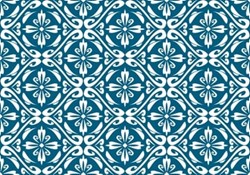
Our study involves both secondary school students and prospective teachers. We developed the course "Issues in Ethnomathematics: Teaching Geometry in Socio-Cultural Context" as part of the departmental curriculum, and run it since 2007.
The course presents visual artifacts as complex geometric structures and provides practice in construction of ornaments using symmetries and transformations. We expose students to galleries of ornaments of different cultures where they analyze their geometrical properties and construct them using compass and straightedge. The study of geometry goes hand in hand with the inquiry of the cultural roots of the ornaments where it enriches learning by adding a cultural humanistic dimension. The course culminates in a workshop "Joyful Learning of Geometry in Cultural Context" in which each student teaches a diverse group of pupils from Jewish and Arab high schools. Each student chose a different culture to present for his pupils. Some chose old cultures such as Old Egyptian, Japanese, Rangoli, and others chose Jewish, Islam and Ukraine to state few. Pupils drew ornaments using compass and straight edge, inquired into the tradition and wrote an essay on it with variety of ornaments from the chosen culture and worked out geometric problems related to the ornament. At the end of the workshop, the pupils presented their work on a poster and all the students presented their works in a gallery set for that purpose.
We carefully followed up the learning of the course and revised it from year to year on the basis of reflection and conceptualization of the research findings. The research instruments include, observations, questionnaires, interviews, analysis of students' performances, and videotaped of students' activities. By triangulation of these data, a detailed description of the learning progress of each student was extracted. We found that the students developed motivation and desire to make a deep inquiry in both mathematical and cultural aspects. Several works demonstrated creativity in geometry and visual design. Students discerned interesting geometrical problems and found original solutions. Most of all, a conceptual change in the perception of geometry happened. The students became aware of ornaments in their environment, seeing them not only as decorations, but as culturally meaningful geometrical patterns possessing interesting geometric transformations and symmetries.